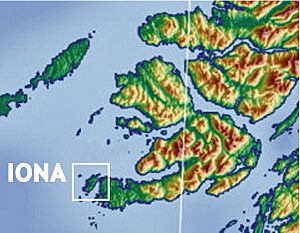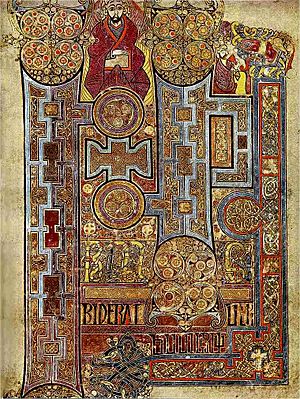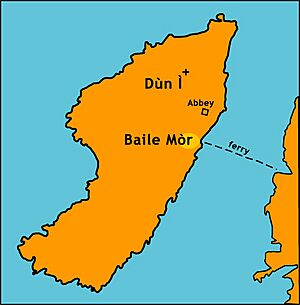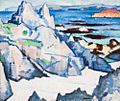Iona facts for kids

Iona (which is called Ì Chaluim Chille in Gaelic) is a tiny island off the west coast of Scotland. It's part of the Inner Hebrides islands.
A long time ago, in 563 AD, a monk named Columba came to Iona with twelve other monks. They started a very important monastery here. Because of this, Iona became known as a special, holy place. It was a major center for Christianity in Scotland for many hundreds of years.
Today, Iona is a popular place for visitors. People come to see its history and to find a peaceful place for spiritual retreats. The Gaelic name for Iona means "Iona of (Saint) Columba."
Contents
The Village
The main town on Iona is called Baile Mòr. It's on the eastern side of the island, in a place called St. Ronan's Bay. Locals just call it "The Village."
In Baile Mòr, you'll find the island's primary school, the post office, and two hotels. There's also the Bishop's House and the old ruins of the Iona nunnery. The famous Iona Abbey and the MacLeod Centre are just a short walk north from the village.
Around Iona, there are several smaller islands. Some of the bigger ones to the north are Eilean Annraidh (which means "island of storm") and Eilean Chalbha ("calf island"). To the west are Rèidh Eilean and Stac MhicMhurchaidh. And to the south, you'll find Eilean Mùsimul ("mouse holm island") and Soa Island.
History
Early History and Saint Columba

Long ago, Iona was part of a kingdom called Dál Riata, which was home to the Gaels. The island became very important because of its monastery during the Early Middle Ages.
People say that the monastery was started in 563 AD by a monk named Columba. He was also known as Colm Cille. Columba had to leave his home in Ireland. So, he and twelve friends came to Iona and built the monastery.
This monastery became very successful. It played a big part in helping the Picts (an ancient Scottish people) become Christians. It also had an impact on the Anglo-Saxons in the kingdom of Northumbria. Many other monasteries were built in Scotland because of Iona's influence. Iona became the center of a large group of monasteries. The monks at Iona also wrote and copied many important documents.
Iona as a Christian Center
The monastery on Iona became the heart of what was known as Celtic Christianity. At that time, there was a disagreement about how to figure out the date of Easter. The monks in Iona used a "Celtic" way, while missionaries from Rome used a "Roman" way.
This problem was solved at a meeting called the Synod of Whitby in 664 AD. At this meeting, they decided to use the Roman system. The Picts started using the Roman system in the early 8th century. Iona itself changed to the Roman system in 716 AD, according to the historian Bede.
Over the next few centuries, Iona's importance lessened a bit. This was partly because of Viking raids. The Vikings attacked Iona many times, starting in 794 AD. They stole treasures from the monastery. Because of these dangers, Columba's important holy items were moved and split between Scotland and Ireland in 849 AD, and the monastery was left empty.
Around the year 800 AD, a very famous book called the Book of Kells was created on Iona. At the same time, the island's tall stone crosses were put up. These crosses had a ring around the top, which became the symbol known as a "Celtic cross."
Kingdom of the Isles
As the Vikings took more control of Scotland's west coast, Iona became part of the Kingdom of the Isles. This was a kingdom ruled by Norse (Viking) leaders.
Even though it was under Viking control, Iona remained important. A king named Amlaíb Cuarán died on Iona in 981 AD. However, the island was attacked again by Vikings in 986 and 987 AD.
The ruling family of Alba (an early name for Scotland) believed their family came from Iona. This made the island a very important religious symbol for the new Scottish kingdom. Many of Scotland's early kings were buried there. The kings of the Isles sometimes answered to the King of Norway, the High King of Ireland, or the King of Scotland. By the 11th century, they were mostly independent, even though they were still linked to Norway.
Around 1208 AD, a convent for Benedictine nuns was started on Iona. Bethóc, the daughter of a powerful leader named Somerled, was the first leader of the nuns. The current Iona Abbey was built around 1203 AD. The monastery was very active until the Scottish Reformation. During the Reformation, many religious buildings were destroyed, and most of the 360 carved crosses on Iona were broken.
Kingdom of Scotland
According to stories, the first "King of Scots" was Kenneth MacAlpin (Cináed mac Ailpín). He helped create what we now call Scotland in 843 AD. From that time until the 11th century, the Reilig Cemetery on Iona was the burial place for Scottish kings.
In total, about forty-eight Scottish kings are buried on Iona. Also, eight kings from Norway and four kings from Ireland are buried there.
After the Treaty of Perth in 1266 AD, the Isles (Hebrides) came back under Scottish rule. The Augustine nunnery still stands today as ruins from the 13th century, including a church and cloister. The nunnery was active until the Reformation. By the 1760s, not much more of the nunnery was left than what you can see today, but it's still the most complete old nunnery in Scotland.
In the 1800s, a type of green-streaked marble was dug up and sold from the southeast part of Iona. You can still see the old quarry and machinery today.
Images for kids
-
Cathedral Rock, Iona, Samuel Peploe (1920), Aberdeen Art Gallery
-
Lunga from Iona, Francis Cadell, Aberdeen Art Gallery
-
Stormy Weather, Iona, Samuel Peploe (ca.1929), Aberdeen Art Gallery
See also
 In Spanish: Iona para niños
In Spanish: Iona para niños















